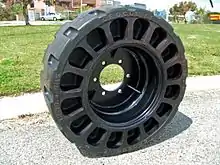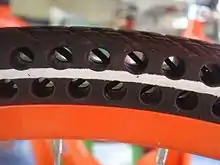Airless tire
Airless tires, non-pneumatic tires (NPT), or flat-free tires are tires that are not supported by air pressure. They are used on some small vehicles such as riding lawn mowers and motorized golf carts. They are also used on heavy equipment such as backhoes, which are required to operate on sites such as building demolition, where risk of tire punctures is high. Tires composed of closed-cell polyurethane foam are also made for bicycles and wheelchairs. They are also commonly found on wheelbarrows which may be used for yard work or construction.

Advantages & disadvantages
The main advantage of airless tires is that they do not go flat. Other advantages are that airless tires need to be replaced less frequently, resulting in savings. Heavy equipment outfitted with airless tires will be able to carry more weight and engage in more rugged activities.
Airless tires generally have higher rolling resistance and provide somewhat less suspension than similarly shaped and sized pneumatic tires. Other problems for airless heavy equipment tires include dissipating the heat buildup that occurs when they are driven. Airless tires are often filled with compressed polymers (plastic), rather than air or can be a solid molded product.
Airless tires are attractive to cyclists, as bicycle tires are much more vulnerable to punctures than motor vehicle tires. The drawbacks to airless tires depend on the use. Heavy equipment operators who use machinery with solid tires may complain of fatigue. Bicycle riders who use airless tires may complain that the tire is harder than a comparable pneumatic tire, however, only anecdotal evidence suggests that airless tires may cause broken spokes on a bicycle wheel. Any airless tire will be heavier than the rubber tire it is meant to replace.
As of 2021, airless tires are not popular with hardcore off-roaders as those vehicles often need to travel long distances at highway speeds. They are unstable, cause severe vibrations (passenger discomfort) and therefore potential for drivers to lose vehicle control at speeds above 80 km/h.[1]
Installation of airless tires depends on the use. Heavy equipment will need special equipment to mount, but an airless bicycle tire can be mounted with little or no effort. Solid airless lawnmower tires come pre-installed on the wheel, allowing quick installation.
Examples

Many bicycle-sharing systems use these tires to reduce maintenance.
In 2005, Michelin started developing an integrated tire and wheel combination, the "Tweel" (derived from "tire" and "wheel," which, as the name "Tweel" suggests, are combined into one new, fused part), which operates entirely without air. Michelin claims its "Tweel" has load carrying, shock absorbing, and handling characteristics that compare favorably to conventional pneumatic tires.[2] However, the tire has a lot of vibration when driving over 80 km/h (50 mph). Therefore the tire is only available for golf carts, ATV's and skid steer vehicles. In 2019 however Michelin and GM announced their goal of making a new airless tire for passenger vehicles available in 2024. [3] The automotive engineering group of the mechanical engineering department at Clemson University is developing a low energy loss airless tire with Michelin through the NIST ATP project.
Resilient Technologies and the University of Wisconsin–Madison's Polymer Engineering Center are creating a "non-pneumatic tire", which is basically a round polymeric honeycomb wrapped with a thick, black tread. The initial version of the tire is for the Humvee and is expected to be available in 2012.[4][5] It is also the first group to make a commercially available mass-produced airless tire after its acquisition by Polaris,[6] albeit only as coupled with their vehicle. The tire trademark is "Terrainarmor".
Bridgestone is developing the Bridgestone Air-Free Concept Tire, which can hold 150 kg (330 lb) per tire.[7]
The Energy return wheel (ERW) has the outer edge of the tire connected to the inner rim by a system of springs. The springs can have their tension changed to vary the handling characteristics.[8]
In 1938, J. V. Martin in the United States invented a safety tire with hoops of hickory encased in rubber and fitted with crisscross spokes of ribbed rubber. It could drive over 100 mm (4 inches) blocks when tested in a springless test car.[9]
Hankook Tire is developing the iFlex airless tire.[10]
See also
References
- "The airless tyre remains elusive". Outback Travel Australia. Retrieved 2021-11-28.
- Mihalascu, Daniel (2010-04-30). "Reinventing the Wheel: a Guide to Michelin's Airless Tire". Retrieved 2015-12-31.
- Golson, Jordan (2019-06-06). "Michelin develops new airless tyre". Retrieved 2020-08-03.
- Rutherford, Mark (2008-11-17). "New honeycomb tire is 'bulletproof'". CNET. Archived from the original on 2009-06-15. Retrieved 2008-11-23.
- Youtube video. Archived from the original on 2011-12-18. Retrieved 2011-12-27.
- Edelstein, Stephen (2013-11-18). "Polaris Airless Tires Go On Sale". Motor Authority. Retrieved 2015-02-15.
- Boyer, Mark (2011-12-31). "Bridgestone Air-Free Concept Tyre". inhabit.com. Retrieved 2012-04-19.
- Michler, Andrew (2011-12-28). "Airless, Springy 'Energy Return Wheel' Tire Promises To Improve Gas Mileage". inhabit.com. Retrieved 2012-04-19.
- "Rubber Spokes Give Bounce to Airless Safety Tires". Popular Science. May 1938. Retrieved 2015-10-20.
- Collie, Scott (2015-07-16). "Hankook's high-speed tests inch airless tires closer to production". GizMag. US. Retrieved 2016-10-02.